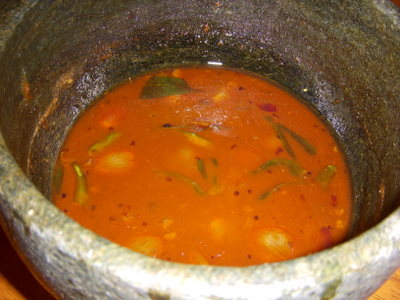Pachai Milagu Kuzhambu (Spicy Green Peppercorn Soup)
After a bout of crazy baking (yes, crazy is the right word when you are waiting for the bread dough to rise at midnight:), it was good to get Girish in the kitchen for some traditional fare.
You can tell by his previous recipes that he is kind of a “Kuzhambu King” – Karuveppalai Kuzhambu, Vetha Kuzhambu, Kaara Kuzhambu are all his staple recipes. The names may be a tongue twister to the unorthodox ear but as any lover of Indian cuisine knows, they are distinctly different and unique to different regions of the South.
Pachai Milagu Kuzhambu is similar to the Karuveppalai Kuzhambu (curry leaves tamarind soup), but the green peppercorns give it a different kind of “burn”. That wasn’t meant to sound scary to newbies to Kuzhambu, but if you don’t know our recipes already, Kuzhambus are meant to have that tangy spice, which provide the perfect antidote to white rice and clarified butter (ghee) or the most famous combination of yoghurt rice and Kuzhambu, very lovingly known as “Thachi Mammu” in our home:)
As I have said this earlier, Singapore is a veggie and fruit haven and fresh green peppercorns, though seasonal are available (something I wouldn’t have dreamed of finding easily in the US). A trip to the local vegetable market (Tekka) and a 10 minute hunt to find a speacialty Thai store was all it took to find green peppercorns by the kilos! Of course we picked up about 300 grams which will probably last us a month or two. Green peppercorns have an extra bite to it and taste tangier than their black counterparts, which makes it a perfect accompaniment for Kuzhambu. Amma is already in the process of pickling the remaining peppercorns in brine the recipe of which I will share later.
Recipe for Pachai Milagu Kuzhambu:
Ingredients:
- Green Peppercorns – 125 grams or about 1 1/2 cups
- Curry leaves – 1/2 cup
- Dry red chilies – 4-5
- Cumin seeds – 1 tbsp
- Tamarind, a lemon sized ball soaked in warm water
- Salt to taste
- Asafetida (hing) – a pinch
- Gingelly oil – 2 tbsp
Method:
1. Take a kadai or heavy bottom vessel and add half the green peppercorns, add red chilies and cumin seeds and dry roast for about 3-4 minutes. The peppercorns will begin to pop. Turn off the heat.
2. Now take this mixture and put it in the blender container. Add the remaining peppercorns (minus about 2 tbsp), tamarind and curry leaves to the blender container. Blend these to a smooth paste adding some water little by little so the consistency is that of a thick sauce.

3. Now heat another heavy bottom vessel (or kachitti, a stoneware vessel), add about 2 tbsp of gingelly oil. Add asfetida to the oil. Heat for about 2-3 minutes till oil begins to smoke a bit.
4. Now add the paste and stir to mix.
Add about 1/2 cup water (to 1 cup, depending on consistency needed) and stir again. Now add the remaining 2 tbsp of fresh green peppercorns to this mixture.
5. Bring this mixture to a boil and let it simmer for 5 minutes till you get an aroma of the peppercorn curry leaves mixture.
6. Serve hot with rice and pappadums or with Thachi Mammu:).






























